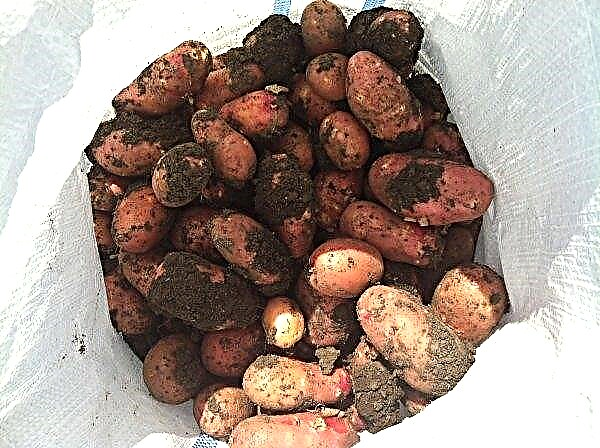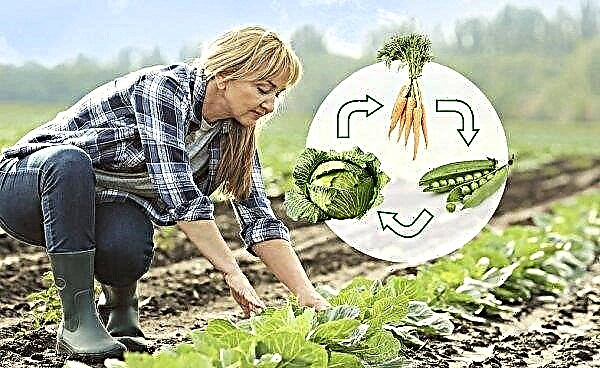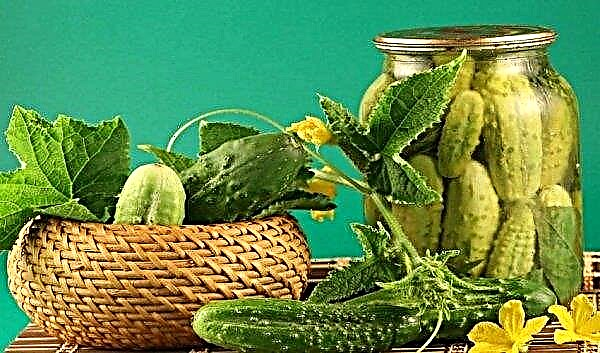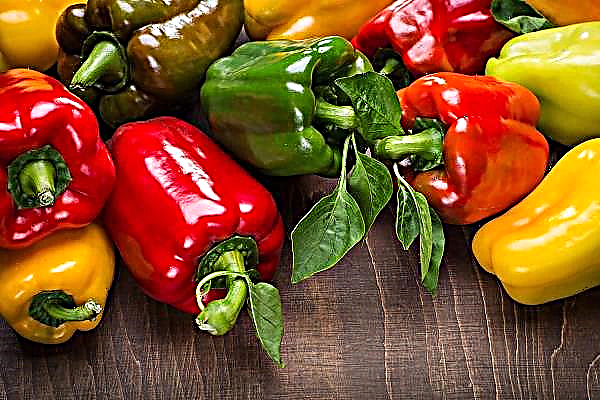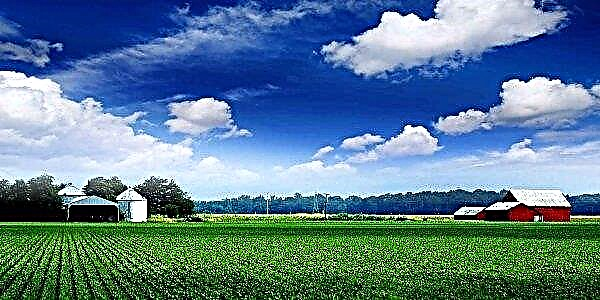The Kolya cabbage variety, echoing the well-known male name, although it has nothing to do with it, is quite popular among medium-sized vegetable growers, not only because of its harmonious and easily remembered name. High productivity, versatility of application and excellent taste with good protection against diseases have opened Kolya a wide road to the beds of farmers and summer residents. Read more about this cabbage variety - later in the article.
Description and characteristic
Officially, this cabbage species is called Kolya F1, which indicates its hybrid origin. Breeders brought him from the seed company Seminis Vegetable Seeds in the Netherlands. The hybrid was obtained with a consistently high yield and good tolerance to various climatic conditions, with the exception of severe frosts.
Did you know? The cabbage head is not a fruit at all, but a huge wintering bud sitting on a stem, the role of which is played by the stump.
Taste and appearance
Hybrid cabbage Kohl F1 has excellent gastronomic qualities. Its taste is equally good both in fresh form, and in pickled or after heat treatment. A feature of the variety is the complete absence of bitterness.
The cabbage head of this hybrid is different:
- rounded and slightly flattened shape;
- slight wavy leaves;
- elongation of the leaf outlet;
- weight up to 8 kg;
- outdoor light green;
- white color on a cut;
- homogeneity of the internal structure;
- the average size of the inner stump.
Productivity and ripening dates
Being a medium-late white-headed hybrid, Kolya F1 cabbage matures within 130–135 days after planting seedlings in the open. The yield of this cabbage averages 498 kg / ha, reaching under favorable conditions 652 kg / ha.
Grade resistance
The hybrid does not have great frost resistance, but it has a strong immunity that protects it from:
- mucosal bacteriosis;
- Fusarium
- vascular bacteriosis;
- thrips.

Advantages and disadvantages
- In conditions of fierce competition of numerous cabbage hybrids, Kolya F1 is different:
- strong immune system;
- high productivity;
- presentation of large heads of cabbage;
- their ability not to crack;
- good keeping quality;
- lack of bitterness in taste;
- universality of application;
- unpretentiousness in leaving;
- adaptability to various climatic conditions.
Serious flaws in this cabbage is not noted. Some difficulties are created by a rather high external stump, which requires regular hilling, without which a large head can sink to one side.
Did you know? The current one hundred species of cabbage is represented by only 3 varieties: cabbage, colored and leafy.
Cultivating varieties
The described hybrid in warm regions can be grown directly from seeds under the open sky, however, in places of its most active cultivation, growing from seedlings is much more often practiced.
Preparing planting material
Basically, the late varieties of cabbage, to which Kolya F1 belongs, are sown for seedlings in early April. More precise dates depend on the growing area. They are easy to calculate, if you keep in mind that the seeds germinate 8-10 days after sowing, after which it should pass from 50 to 55 days before planting seedlings in open ground. Soil for seedlings is prepared from the same parts of turf land, peat and river sand, to which wood ash is added at the rate of half a glass per 2 liters of soil mixture.
Soil for seedlings is prepared from the same parts of turf land, peat and river sand, to which wood ash is added at the rate of half a glass per 2 liters of soil mixture.
Prepared soil must be treated with pink potassium permanganate solution or Maxim fungicide. Seeds before the sowing also need to be disinfected, for which they are placed for a third of an hour in a dark pink solution of potassium permanganate and then washed in clean water.
Growing seedlings
Following disinfection, cabbage seeds must be dried. Then they are laid out on the surface of the prepared soil mixture, placed in containers.
They may be as follows:
- wooden low boxes;
- special containers;
- plastic cups;
- peat cups;
- cardboard cups.
It is also convenient to use peat pellets, which are made from peat with the addition of nutrients. Seeds are located on the ground no closer than 1 cm from each other, since cabbage shoots do not tolerate thickening. Then they are covered with a soil mixture up to 1.5 cm thick. After planting the seeds, the soil must be sprayed with sprayed water from the sprayer. Then containers with seedlings are covered with glass or a transparent film to create greenhouse conditions and placed in a place with an ambient temperature of about + 20 ° С. Seeds covered with a film. After emergence in 8-10 days, the temperature should be reduced to + 8 ... + 10 ° С. This need is due to the fact that at higher temperatures the sprouts quickly stretch, begin to hurt and often die. And after 10-14 days, the daily temperature must be brought to + 15 ... + 17 ° C, leaving the night temperature unchanged. The temperature difference is useful to plants, stimulating their development and hardening them.
Seeds covered with a film. After emergence in 8-10 days, the temperature should be reduced to + 8 ... + 10 ° С. This need is due to the fact that at higher temperatures the sprouts quickly stretch, begin to hurt and often die. And after 10-14 days, the daily temperature must be brought to + 15 ... + 17 ° C, leaving the night temperature unchanged. The temperature difference is useful to plants, stimulating their development and hardening them.
Watering the seedlings during this period should be moderate, with the drying of the soil between waterings. With the appearance of a pair of real leaves in the sprouts, seedlings growing in plastic or wooden containers need to be dived. The remaining containers should be placed in the most lit places with a temperature of + 15 ... + 17 ° С. Seedlings are still moderately watered at room temperature with water and fed twice. The first time this happens after the appearance of the seedlings 2 real leaves.
Important! Insufficient deepening of seeds can lead to the removal of seed shells to the surface along with seedlings, which inhibits the development of seedlings.
In the prepared soil with the addition of wood ash, in which the seeds were sown, there are still all the necessary useful substances, except nitrogen. Its deficit can be filled, for example, with urea, a solution of which is prepared by adding 30 g of this fertilizer to a bucket of water. When 3-4 real leaves appear on a seedling, it is fed with full mineral fertilizer, designed specifically for seedlings.
Technology for planting seedlings in open ground
Seedlings are ready for planting in open ground after the appearance of 5-6 developed true leaves on it.
The place for the garden should be chosen where before the predecessors of cabbage were:
- carrot;
- peas;
- beans;
- potatoes;
- garlic;
- bow.
Do not plant cabbage after:
- cruciferous crops;
- radish;
- radish;
- arugula.
Important! You should not plant cabbage in the same place earlier than 4 years have passed.
The landing process proceeds as follows:
- Tanks with seedlings for a couple of hours before planting in open ground should be abundantly watered.
- While seedlings are saturated with moisture before planting, it is necessary to prepare the planting holes with the addition of 1 glass of wood ash, 1 tbsp. Each. l double superphosphate and 1 part urea.
- Having mixed fertilizers with the soil, it is necessary to deepen the hole to such a depth that the seedlings fit in it until the first true leaf.
- Then the hole should be filled with water.
- After absorbing half the water, the hole should be filled with soil, without compacting it after that.
- To prevent the rapid evaporation of water and the formation of a crust on the soil surface, which prevents the air exchange of the root system, it is useful to mulch the earth around the seedlings.

Plant care
As already mentioned, a distinctive feature of Kolya F1 cabbage is its low maintenance requirements. However, in order to obtain a good harvest and maintain good immunity, it is necessary to follow basic agricultural rules.
Watering technique
Recently planted seedlings require regular but moderate watering. It is very important to maintain water balance, preventing both drying out of the soil and stagnation of moisture in the root system. Adult cabbage needs more intensive watering. Its frequency depends on weather conditions. In normal weather, the vegetable is watered every 5-7 days. In the dry period, the frequency of watering increases to an interval of 1 time in 3 days. The optimum soil moisture for cabbage is 70–75%.
Water the cabbage only with warm and settled water. To achieve a higher yield of vegetables, they are fed 4 times during the growing season. Feeding at the stage of heading of cabbage is especially relevant. Fertilize cabbage with organic fertilizers, ash and mineral fertilizers with a predominance of potassium, nitrogen and phosphorus in them.
Loosening
For the first time, the soil around a seedling is loosened to a depth of 5 cm a week after planting it in open ground. The following loosening is brought to 8 cm depth. The soil should be loosened after every rain or watering to prevent the formation of a crust on the ground, which prevents the access of oxygen to the roots.
As already noted, the high external stump of this cabbage is capable of falling to one side under the weight of a head of cabbage. In order to avoid this, the vegetable must be promptly spudded. The first time this is done 3 weeks after transplanting seedlings in open ground. After a couple of weeks, the hilling is repeated.
Disease and Pest Prevention
Having the ability at the genetic level to resist mucous and vascular bacterioses, fusarium and pests in the form of thrips, the Kolya cabbage hybrid under adverse conditions and violation of agricultural regulations can be susceptible to the disease:
The heads of cabbage affected by these diseases are removed, and the rest are treated with colloidal sulfur, as well as with Oksikhom or Abiga-Peak, to prevent the disease.Important! Handle cabbage with these substances should be until the head starts to tie. After this, treating the vegetable with toxic substances is strictly prohibited.
A threat to the vegetable and pests represented by:
- cabbage fly, which is a dangerous enemy of cabbage seedlings, to prevent the attack of the larvae of which vegetables are sprayed with 80 percent technical dichlorvos or with Fury, Nemabakt, and Iskra-M;
- leaf-eating pests in the form of whites, dustpan, cabbage aphids and bedbugs, which are fought by treating the vegetable with a 0.2 percent solution of 80 percent technical chlorophos or “Phosphamide”.
 Cabbage fly is the worst enemy of cruciferous garden crops.
Cabbage fly is the worst enemy of cruciferous garden crops.Harvesting and storage
Being a mid-late hybrid, Kolya F1 matures in late summer and early fall. The ripeness of heads of cabbage is easily determined by their density. The collection of medium and late cabbage is usually carried out by pulling the vegetable out of the ground, followed by chopping the stalk immediately before laying it for storage. It is best to head out in dry and cool weather at a temperature of +4 ... + 7 ° C. Warmer weather provokes withering and decay of heads of cabbage.
Before laying for storage, the heads of cabbage must be sorted according to the principle: the denser the cabbage vegetable, the better it will be stored. For winter storage, it is best to choose heads of cabbage with 2 green covering leaves. Cabbage is stored in a basement or cellar at a temperature of -1 ... + 2 ° C with an air humidity of 91–97%. Heads of cabbage are laid out on a wooden floor in a checkerboard pattern in 2-3 rows, with stitches up. You can hang vegetables on the crossbars, tying them in pairs.
Under optimal conditions, Kolya F1 cabbage is able to maintain all its qualities for 10 months. The Western European cabbage hybrid Kohl has taken root well in our area, occupying ever-larger areas in farms and in amateur gardens. Cabbage with an apparent family name Kolya won sympathy for its unpretentiousness in care, high productivity and wonderful gastronomic qualities.


